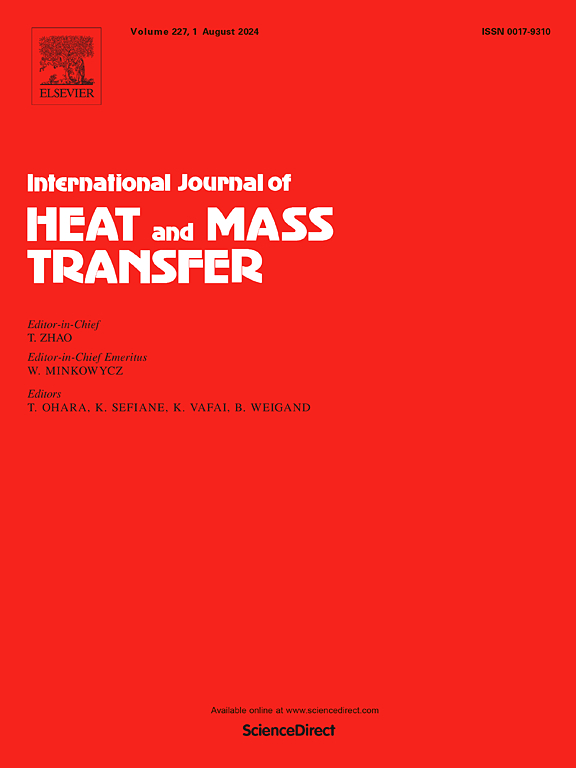脉动热管中途停留状态的实验与数值研究
IF 5.8
2区 工程技术
Q1 ENGINEERING, MECHANICAL
International Journal of Heat and Mass Transfer
Pub Date : 2025-04-26
DOI:10.1016/j.ijheatmasstransfer.2025.127102
引用次数: 0
摘要
本文将先前使用配置为11转脉动热管(PHP)的“Smart loop”(Abela et al. 2024)获得的实验数据与使用内部一维瞬态代码CASCO (code avancede simulation du Caloduc Oscillant的法语首字母缩写:Advanced PHP simulation code in English)第4版获得的模拟结果进行比较。CASCO已经在几何、拓扑、材料特性和热边界条件方面进行了设置,以模拟实验装置。在多个参数下,同时对数值结果和实验结果进行了比较。首先,我们比较了整体的传热性能与良好的协议。然后讨论了固定位置流体温度和压力的时间演化。对中途停留制度进行了深入的研究。发现它的特点是一个重复序列的快速压力增长(对应于振荡),然后是一个较慢的压力衰减(对应于PHP中途停留)。对实验数据和仿真数据进行了主频率计算;达成了协议。压力衰减率的实验数据与模拟数据也基本一致。随着热负荷的增加,PHP热阻降低的原因是由于液膜干燥速度加快,出现较大的压力衰减率,从而减少了停留时间。本文章由计算机程序翻译,如有差异,请以英文原文为准。
Experimental and numerical studies of the pulsating heat pipe stopover regime
The experimental data previously obtained with a “Smart loop” (Abela et al. 2024) configured as an eleven-turn pulsating heat pipe (PHP) are compared here to simulation results obtained with the in house 1D transient code CASCO (French acronym for Code Avancé de Simulation du Caloduc Oscillant: Advanced PHP Simulation Code in English) version 4. CASCO has been set-up in terms of geometry, topology, material properties and thermal boundary conditions to mimic the experimental device. A comparison between numerical and experimental results is performed simultaneously on multiple parameters. First, we compare the overall heat transfer performance with a good agreement. Then we discuss the temporal evolution of fluid temperature and pressure at fixed locations. The stopover regime is deeply investigated. It is found that it is characterized by a repeating sequence of fast pressure growth (corresponding to oscillations) followed by a slower pressure decay (corresponding to PHP stopover). The dominant frequency was computed both for experimental and simulation data; an agreement was found. Similarly, the experimental and simulation data on the pressure decay rate agree. The decrease of the PHP thermal resistance with heating load is explained by a decrease of the stopover time caused by a larger pressure decay rate appearing because of a faster liquid film drying.
求助全文
通过发布文献求助,成功后即可免费获取论文全文。
去求助
来源期刊
CiteScore
10.30
自引率
13.50%
发文量
1319
审稿时长
41 days
期刊介绍:
International Journal of Heat and Mass Transfer is the vehicle for the exchange of basic ideas in heat and mass transfer between research workers and engineers throughout the world. It focuses on both analytical and experimental research, with an emphasis on contributions which increase the basic understanding of transfer processes and their application to engineering problems.
Topics include:
-New methods of measuring and/or correlating transport-property data
-Energy engineering
-Environmental applications of heat and/or mass transfer

 求助内容:
求助内容: 应助结果提醒方式:
应助结果提醒方式:


